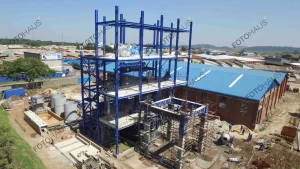TRADE Kings Zimbabwe’s new detergent plant in the Workington area of Harare is impressive and definitely not easy to miss. The six-storey tall blue process building and adjacent spray-drying tower are the most prominent features of this project, visible from quite a distance. However equally impressive once on site is the engineering, design and workmanship within the warehouses and around the main process buildings.
A timely and welcome addition to the Workington area which at present is characterised by out-dated and run-down warehouses, buildings and manufacturing plants. Through this investment and having concluded construction in August of this year, Trade Kings Zimbabwe will very shortly commence local manufacturing of various detergent brands and products including the popular Boom and Xtra Detergent Powders and Paste. These products have until now been imported from Zambia through Zim-Kings Trading, local Distributors of various Fast Moving Consuming Goods.
The decision to invest into a manufacturing plant for these products was motivated by the huge success of the above detergent brands over the past few years, together with the Government’s call for companies to move towards local manufacturing instead of importing products. Subsequently, in late 2014 Trade Kings Zimbabwe formally presented a document to The Government of Zimbabwe that outlined their ability, resolve and commitment to invest US$50 million over a five-year period starting in 2015 into the Fast Moving Consumer Goods (FMCG) manufacturing sector in Zimbabwe.
The detergent plants project represents the initial phase of this investment, estimated to be in the region of approximately US$15million. Situated at numbers 10 and 14 Douglas Road in the Workington area of Harare, Trade Kings Zimbabwe are currently commissioning both plants and hope to commence manufacturing before the end of 2017. Commercial production was originally scheduled for late-2016 but due to unforeseen circumstances this was delayed until this year. Once operational, Trade Kings Zimbabwe will initially produce 1,000 tonnes per month of detergent powder and paste product, making them the only large-scale manufacturer of detergents within the country.
The total plant capacity however, is 3500 tonnes per month of detergent product. The strategic goal for Trade Kings Zimbabwe is to steadily increase production to full capacity over a 2-3 year period, wherein approximately 1,500 tonnes per month will be made available for local consumption and the balance available for export into neighbouring countries including Mozambique, Botswana, Malawi, South Africa and Zambia. In addition to this, Trade Kings Zimbabwe will employ between 250 and 300 people – many of whom will be directly involved in production and develop skills associated with state of the art machinery and equipment. The modern high-tech detergent plants have been supplied by Ballestra S.p.A of Italy, world renowned leaders in spray drying technology and plants of this nature who have worked closely with local artisans, technicians and Trade Kings Zimbabwe staff in training them on the use and operation of their technology.
The design of the structure is specifically geared towards the unique manufacturing process required for dry powder detergents. The manufacturing and packaging plant is highly automated and continuously computer monitored for efficiency and safety. The blue tower, complete with kingfisher blue cladding accommodates all the processing equipment to produce powder slurry which is then sprayed into the tower. Within the tower various dry and liquid raw materials are mixed and processed in a series of stages to produce a powder slurry. The various supporting infrastructure and utilities including compressed air, steam and process water are all fed into the process building. Construction of the process building was the most complex engineering feat of this project. It began by demolishing the old collection of small buildings on the site, excavating weak soils and backfilling much stronger soils brought into site. This was followed by piling foundations and the casting of an enormous concrete slab. The tower was then built floor by floor, starting with the steel skeleton of massive beams all bolted together. The exterior Chromadek cladding was attached to the skeleton and the interior staircase was welded into place. Because of the unusual height of the structure it has been designed to be able to vibrate slightly in response to wind, temperature and other factors.
Using a kind of formwork called Bondek the ‘ceiling’ of the ground floor was constructed and the concrete slab cast on top. Bondek is an extremely strong type of formwork ideal for concrete slabs that remains in place forming a permanent composite block, saving on the cost of steel reinforcing. It also helps save construction time and it allows for longer spans to be cast. Each slab had to have voids to allow pipework and other equipment to pass through, and it had to have bolts set into the concrete to fix the associated apparatus. The process was repeated over six floors. Fitting the final crowning piece of equipment – a giant steel tank like structure – was quite an engineering feat in itself. The structure had to be lifted up six floors in one piece by crane and then gently lowered onto the bolts to secure it.
The bolts had been set into the concrete slab and there was practically no tolerance if the bolts didn’t line up correctly. Thankfully it fitted into place perfectly. From the process building, detergent powder slurry is fed into the spray drying tower. This silo-like tower hanging off a massive ring beam is in effect an enormous drying and evaporation tower which reaches temperatures of up to 350 degrees centigrade. The flues are vents which supply hot air to the tower as required for drying purpose. The crow’s nest structure near the top of the silo allows workers to monitor the inside of the silo and control a series of rings which move up and down inside the tower scouring the sides to clean accumulated debris.
Interestingly, this part of the process is extremely environmentally friendly as no waste is produced at all, and the entire process has been approved by the Environment Management Agency (EMA). From the spray tower the dried powder is then post-dosed to add perfumes, speckles and other heat sensitive chemicals before being conveyed into a series of hoppers, within the packaging section. Currently the plant is packaging the product into buckets, boxes and sachets but it will soon be packaging washing paste as well. Like the whole manufacturing process the packaging section is also highly automated and computer monitored with different packaging machines supplied from Italy, India and South Africa. Unlike the powder plant referred to above, the detergent paste plant is a much simpler and smaller operation that has been neatly designed and constructed within one of the warehouses.
Paste production utilises the same raw materials as for powder and following a series of mixing and dosing is packaged directly as a semi-liquid product into sealed packaging. Both plants, including the structure and the equipment together with a significant amount of pre-fabricated steel, was shipped and assembled on site in over 70 container loads. Construction within the plants was managed using local contractors whereas the mechanical installation, instrumentation and electrical installation was done by local labourers working closely with Ballestra engineers. Similarly commissioning of the plants and packaging machinery will be done by the Engineers sent from the various suppliers, who will train Trade Kings Zimbabwe in the operation and maintenance of such high tech machinery. Trade Kings Zimbabwe managed the project through Piet Rinke, a specialist in civil engineering structural design and project management together with Rory Harley – a specialist in process and chemical engineering.
Text by Michael Nott
Photos Supplied by Boom and Tami Zizhou









